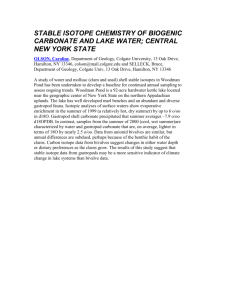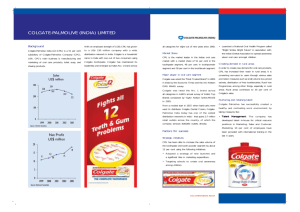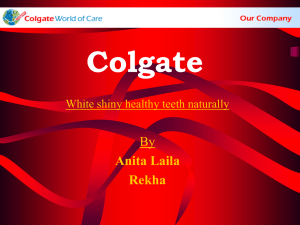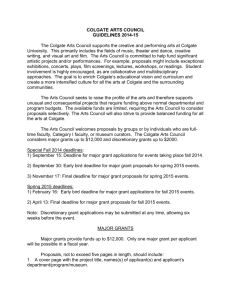Planet - Colgate
advertisement
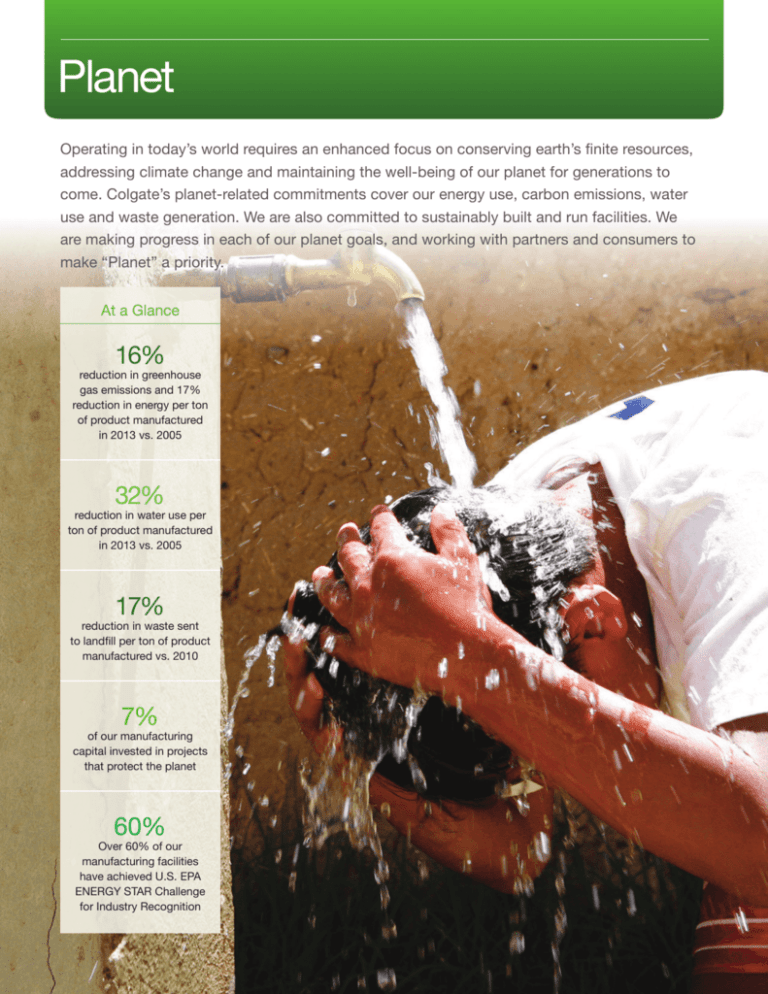
Planet Operating in today’s world requires an enhanced focus on conserving earth’s finite resources, addressing climate change and maintaining the well-being of our planet for generations to come. Colgate’s planet-related commitments cover our energy use, carbon emissions, water use and waste generation. We are also committed to sustainably built and run facilities. We are making progress in each of our planet goals, and working with partners and consumers to make “Planet” a priority. At a Glance 16% reduction in greenhouse gas emissions and 17% reduction in energy per ton of product manufactured in 2013 vs. 2005 32% reduction in water use per ton of product manufactured in 2013 vs. 2005 17% reduction in waste sent to landfill per ton of product manufactured vs. 2010 7% of our manufacturing capital invested in projects that protect the planet 60% Over 60% of our manufacturing facilities have achieved U.S. EPA ENERGY STAR Challenge for Industry Recognition Planet Reducing Energy Use and Greenhouse Gas Emissions Colgate named a U.S. EPA ENERGY STAR Partner of the Year 2014 for the 4th year in a row, and 61% of our manufacturing facilities have achieved U.S. EPA ENERGY STAR Challenge for Industry Recognition Reducing Energy in Colombia Colgate has reported to CDP on our carbon emissions since 2004. In 2013 we were named to the Carbon Disclosure Leadership Index. 155 0.475 150 0.450 145 0.425 140 0.400 135 0.375 130 0.350 125 2005 2006 2007 2008 2009 2010 Carbon Emissions Intensity 2011 2012 2013 0.325 Energy Intensity 2005 to 2013 Manufacturing Carbon Emissions and Energy Intensity Announcing Our New Climate Change Commitment By 2020 we will reduce carbon emissions on an absolute basis by 25% compared to 2002, with a longer term goal of a 50% absolute reduction by 2050 compared to 2002. These goals are in line with the CDP and World Wildlife Fund report – The 3% Solution – and will allow us to play our part in limiting global warming to 2°C, as recommended by the Intergovernmental Panel on Climate Change. kilowatt hours x 1000 / ton of product Our 2015 goal is to reduce the energy consumption and carbon emissions per unit of production associated with the manufacture of our products by 20%. We are on track for this reduction, with a 17.1% reduction in energy, and a 16.3% reduction in carbon emissions per unit of production in 2013 vs. 2005. kilograms of CO2 / ton of product kilowatt hours x 1000 / ton of product We believe businesses have a vital role to play in mitigating climate change, and we are committed to continuously improving our greenhouse gas governance and performance around this challenge. Planet Our Oral Care Carbon Footprint In order to better understand the life-cycle carbon footprint across our global Oral Care product category, we have developed an innovative approach to estimating “Scope 3,” or indirect emissions that result from our business, but arise from sources controlled by others. We estimated that over 75 percent of our carbon footprint comes from the materials we purchase from suppliers. Currently, we are focusing on the most carbon-intensive raw materials and working with key suppliers to assess the greatest opportunities for reduction. 50x Upstream emissions including sourcing of materials and services 1x Emissions from Colgate manufacturing 3x Downstream distribution of products 10x Use and disposal of products Oral Care Carbon Footprint Estimated Breakdown Illustration of the footprint of a consumer brushing his or her teeth with toothpaste and a toothbrush. Graphic shows a relative breakdown. “3x” is three times as large as “1x,” etc. Renewable Energy We are continuing to evaluate alternative energy and renewable energy sources such as solar, fuel cells, green power and cogeneration for feasibility and applicability in various locations worldwide. We have installed on-site renewable energy in the form of solar panels in Mexico and Italy, and use solar water heating at many sites. In 2014, Colgate plans to join the U.S. EPA’s Green Power Partnership to better understand how verified market-based renewable solutions can complement our main climate change strategy of energy efficiency everywhere. Moving Products to Consumers In 2013, Colgate continued an aggressive initiative to increase the reporting and analysis of CO2 associated with the distribution of our products (logistics). In 2013, we estimated the carbon impact for approximately 85 percent of the movement of our finished goods. In both the U.S. and Europe, we have reduced our logistics CO2 emissions by over 10 percent per ton of finished goods moved. We are also working to increase the amount of intermodal transportation — by which goods are shipped in an intermodal container or vehicle that can move through different modes of transportation, such as by sea and rail. When compared with using trucks and aircraft, intermodal transportation reduces greenhouse gas emissions and reduces cost. In the U.S., Colgate-Palmolive and Hill’s Pet Nutrition are U.S. EPA SmartWay Transport Partners. Planet Water Conservation, Access and Awareness Water is one of life’s most basic needs, and it is essential for business growth as well. Water is an ingredient in many Colgate products and is required in almost every phase of the product life cycle: from sourcing raw materials, to producing products, to consumer use of products. Clean water is also vital to the communities we serve and is an increasingly scarce resource in some regions of the world. Colgate’s 2015 goal is to reduce the water consumed per unit of production in the manufacture of our products by 40 percent vs. 2005. We are on track, with a 32.4 percent reduction as of 2013. cubic meters / ton of product 1.6 1.5 1.4 1.3 1.2 1.1 1.0 2005 2006 2007 2008 2009 2010 2011 2012 2005 to 2013 Manufacturing Water Usage Intensity* *Not including water in products Reducing Water Use in Mexico Our water stewardship program at our Mission Hills, Mexico, facility has been assessed as best-in-class for water management, with practices in place to reduce water use and treat wastewater for reuse. 2013 Planet 2013 Water Highlights In 2013, Colgate’s Global Manufacturing Water Reduction Team delivered several exciting new improvement initiatives. The team began developing a standard Water Balance Tool for our facilities to identify and measure complex water flows throughout our manufacturing processes. This tool will assist sites in prioritizing water reduction opportunities. Additionally, the team helped develop a new Colgate Water Stewardship standard that broadens facility water programs to include water conservation, water risk assessments and technical engineering applications that help reduce water. The standard is being launched globally in 2014, supported with an e-Learning training course. As a way to continuously assess the risks associated with global water issues, Colgate has developed a strategy to prioritize and act on water risk issues in all geographies. For several years this has included both geographical and local evaluations of risks and opportunities. Colgate uses the Global Water Tool from the World Business Council for Sustainable Development to evaluate water stress conditions (both current and predicted) in geographies where we have manufacturing sites and key suppliers. We have also used the Global Environmental Management Initiative (GEMI) water management risk assessment questionnaire to help manufacturing sites in water-stressed areas evaluate their potential water risks related to water supply, reliability, economics, compliance and community relations. Additionally, we have engaged experts to undertake targeted water risk assessments at selected locations in Mexico and India. Finally, we will begin using the World Resources Institute (WRI) Aqueduct tool to assess a variety of water-related risks, including water stress, drought and flood. Further details of Colgate’s risk management related to both climate change and water availability can be found in our response to CDP’s annual climate change and water surveys. We have avoided enough water consumption to fill 5,700 Olympic-sized swimming pools Uncovering the “True” Cost of Water In 2012, Colgate partnered with the Rutgers University Business School and its Supply Chain Management Program to develop a “True” Cost of Water Toolkit. This manufacturing-based toolkit is meant to give visibility to many of the hidden costs related to water usage, such as energy, material and treatment costs, thus giving a truer representation of both the cost of using water and the financial benefits of reducing water. In 2013, the “True” Cost of Water tool was launched within Colgate with broad participation from our global manufacturing sites. The results indicated an average “true” cost of water that was 2.5 times more than the purchase cost alone. This information is now being used to provide more accurate savings calculations associated with water reduction projects. In 2014, we are enhancing the toolkit to provide sites the ability to easily and consistently track their water recycling and reuse rates. Planet Providing Access to Water One of Colgate’s 2011 to 2015 Sustainability Strategy goals is to work with local and global organizations to help promote access to clean water. To accomplish our goal, we launched our partnership with Water For People in 2013. Through Colgate’s sponsorship, Water For People reached over 10,000 people with water, sanitation systems and health and hygiene education in both India and Guatemala. Colgate also delivered our “Bright Smiles, Bright Futures” (BSBF) oral health and handwashing education programs in some of the schools that received clean water. Colgate will continue our partnership with Water For People in 2014 to support their goal of 100 percent drinking water coverage in 30 districts across ten countries by 2018. Colgate will expand our partnership to sponsor projects in Guatemala, Peru and India. Colgate will continue our sponsorship of “Play Pumps” in South Africa, which provide an opportunity for children to play and help villages obtain clean water from wells. Colgate now sponsors 25 pumps. Partnering with Water For People in Guatemala Colgate employees visited schools that received clean water through the collaboration with Water For People. Together they built a playground, fixed desks and brightened up a new water station with a colorful mural. Colgate volunteers also taught the “Bright Smiles, Bright Futures” oral care education and handwashing programs to children. Planet Reaching Consumers with Conservation Messaging We are working to make products that require less water or require cold water vs. hot (thus using less energy and generating fewer emissions), including Suavitel No-Rinse Fabric Softener in Latin America, Palmolive Cold Power dish detergent in Europe, and Cold Power laundry detergent in Australia. As many of our consumer products require water for use, consumers have a powerful role to play in helping the environment as they use our products, through actions such as turning off the tap while brushing their teeth and washing their hands, and taking shorter showers. In order to help consumers in this effort, Colgate committed to promote water conservation awareness among over two billion consumers. So far, we have reached 250 million people with reminders on our packaging, in-store campaigns, and through our “Bright Smiles, Bright Futures” oral health and our handwashing awareness programs. Turn the water off when you brush to save up to 2,800 gallons of water annually. Tom’s of Maine partnered with grocery chain Hannaford in the U.S. during Earth Day to encourage consumers to save water. Reducing Waste Colgate has a 2015 target to reduce waste sent to landfills from our operations by 15 percent per unit of production. So far, we have exceeded our target, reducing waste by 17 percent in the past three years. Our sites have been working on this initiative for many years. We have developed standardized Landfill Waste Scorecards for all of our sites to help increase the visibility and understanding of our waste reduction opportunities. Additionally, we recently developed and piloted a third-party assurance program where independent auditor Bureau Veritas visited several Colgate manufacturing sites and subsequently validated our “zero” landfill waste definition and management process. Colgate partners with eco-innovator Terracycle in the U.S., Mexico, Brazil, Germany, Switzerland, Austria and Argentina. Terracycle “upcycles” Colgate packaging collected at schools, stores and other locations into new and affordable eco-friendly products, while generating revenue for schools and charities. Waste Progress Year “Trash to Treasure” in the U.S. Colgate piloted a “Trash to Treasure” event at our Cambridge, Ohio, plant in 2013 to better understand the types of trash produced at the site and identify opportunities to reduce waste. Everyone rolled up their sleeves to dig through the garbage and identify what could be recycled or reused. The plant will use the findings to further reduce waste in 2014, as Colgate rolls out the “Trash to Treasure” program at other sites this year. TotalWaste Waste Recycled/ Generated Reused (MT x 1000) (MT x 1000) 2010126.0 2011129.3 2012128.7 2013136.5 75.7 80.0 81.5 92.2 Reduced waste sent to landfill per ton of product by 17% since 2010. Planet Commitment to Sustainable Buildings Colgate has eight Leadership in Energy and Environmental Design (LEED) certified facilities around the world and is currently working on several additional LEED construction projects in the U.S., Latin America, Asia and Europe. LEED is an internationally recognized green building certification system. Not only do the buildings reduce Colgate’s environmental impact, but the new site locations also reduce the Company’s overall exposure to water and climate change related issues. Additionally, 61 percent of Colgate’s manufacturing sites have achieved U.S. EPA ENERGY STAR Challenge for Industry recognition for improving energy efficiency by at least 10 percent within five years. Piscataway, New Jersey Swidnica, Poland Sanxiao, China Emporia, Kansas Morristown, Tennessee Hustopece, Czech Republic Bangpakong, Thailand My Phuoc, Vietnam “LEED” and related logos are trademarks owned by the U.S. Green Building Council and are used by permission Commitment to Sustainable Buildings Planet Environmental Management It is Colgate’s worldwide policy to manufacture and market our products and operate our facilities so that we conform to, and often exceed, applicable environmental, health and safety rules and regulations. Our Environmental, Occuptional Health and Safety (EOHS) standards, including the Management Systems Standard, define environmental performance expectations for Colgate facilities. All Colgate facilities have a fully implemented EOHS Management System, covering a wide range of categories, including energy, water and waste management. Colgate’s manufacturing environmental performance goals are included in our Global Supply Chain annual objectives, which are cascaded to site-level facility managers, energy managers and EOHS managers. To ensure compliance with Colgate standards, Colgate audits all of our manufacturing facilities, owned and operated warehouses, research and technology centers and large office locations under management control. Audits are performed by a team of Colgate EOHS professionals from locations independent of the specific site being audited. (See page 43 for more information on supplier environmental performance). Managing Risk Prudent environmental risk management is key to the well-being of the Company and the delivery of our strategic objectives. We utilize an Enterprise Risk Management Program to identify, assess, prioritize and manage risks. These risks are evaluated from a multidimensional perspective and consider probability, severity and adequacy of mitigation. The Enterprise Risk Management Committee is sponsored by the Chairman, President and CEO of the Company and includes representation from key internal business leaders. Risks are collectively identified across the organization and are classified within the Strategic, Financial, Operational, Information Technology, Legal & Compliance and Emerging Risk categories. Each risk category is assigned an owner who is also a member of the Enterprise Risk Management Committee and who is ultimately accountable for successfully managing the identified risk. Sustainability-related risks are represented across several risk categories. Further detail of our risk management strategies related to both climate change and water availability can be found in our response to CDP’s annual climate change and water surveys. Local Recognition Colgate sites around the world have been recognized by organizations in their local communities for their industry-leading environmental management: Vietnam Colgate’s Ho Chi Minh Plant received the Green Business Award from the People’s Committee of Ho Chi Minh City, Saigon Giai Phong Newspaper, and Natural Resources and the Environment Department. U.S. Our Morristown, TN facility was recognized as the Tennessee Recycling Coalition’s 2012 Business Recycler of the Year for implementing key recycling initiatives and establishing external partnerships. Mexico The Reforestamos México A.C., a civil association, recognized our Mission Hill plant and Colgate-Palmolive Mexico for their contribution to Mexican forests and environmental protection measures.


